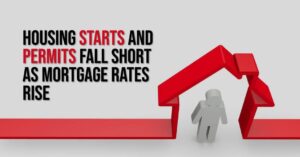The housing market continues to be a two-sided coin. Let's dissect the latest data for April 2024 and unpack its meaning for real estate investors, incorporating the nitty-gritty details to inform your investment strategies.
Housing Starts and Permits Fall Short as Mortgage Rates Rise
Rising Rates Put Builders on Hold (Building Permits Down)
Spiking mortgage rates are causing builders to hit the pause button. New home construction in April came in lower than expected and permits for future projects dipped. Building permits for privately-owned housing units authorized in April were at a seasonally adjusted annual rate of 1,440,000.
This represents a 3.0% decrease from the revised March rate (1,485,000) and a 2.0% decline compared to April 2023 (1,470,000). This suggests builders are adopting a wait-and-see approach as borrowing costs climb due to the Federal Reserve's decision to maintain high interest rates.
Starts Stall, But Completions Climb (Starts Mixed, Completions Surge)
Intriguingly, while groundbreaking for new homes slowed down (privately-owned housing starts clocked in at a seasonally adjusted annual rate of 1,360,000, reflecting a 5.7% increase from March but 0.6% lower than April 2023), builders are diligently working to finish projects already in the pipeline.
Completions of single-family homes, in particular, jumped a significant 15% compared to March. This could be a sign that the inventory crunch may finally ease up, potentially offering some relief to buyers. Here's a breakdown of the key figures:
- Total housing starts: 1,360,000 (up 5.7% from March, down 0.6% from April 2023)
- Single-family starts: 1,031,000 (down 0.4% from March)
On the other hand, single-family home starts dipped slightly (0.4% decrease from March). This suggests a cautious approach to new single-family construction despite the overall increase in total housing starts. However, the real story lies in completions:
- Total housing completions: 1,623,000 (up 8.6% from March, up 14.6% from April 2023)
- Single-family completions: 1,092,000 (up 15.4% from March)
This surge in completions (1,623,000, exceeding both March's estimate and April 2023's figure) could translate into a bit more breathing room for buyers, especially first-timers who've been squeezed out by low inventory and high prices.
Builder Sentiment Takes a Dip
The National Association of Home Builders (NAHB) reported a decline in builder sentiment for the first time since November. This indicates that builders are less optimistic about the market's future. Higher interest rates, tighter lending standards (reflected in the decrease in building permits), and a general air of uncertainty are all contributing factors.
The mixed bag of data from April underscores the importance of staying informed as a real estate investor. While national trends provide valuable context, understanding the intricacies of your specific market is crucial for making sound investment decisions. Here are some actionable steps you can take:
- Deep Dive into Local Numbers: Don't just rely on national headlines. Research permit issuance, housing starts, and completion rates in your target market. This will give you a clearer picture of the local supply-and-demand dynamics. Look for trends that may differ from the national data. For example, while single-family starts dipped slightly nationally, they could be booming in your specific area.
- Connect with Local Experts: Build relationships with real estate agents and property managers in your area. They can provide valuable insights on local market trends, rental rates, and potential investment opportunities. They can also offer guidance on specific neighborhoods that may be poised for growth or areas where overbuilding could lead to a dip in rental income.
- Monitor Completion Rates Closely: The significant rise in completions observed nationally is a trend worth keeping an eye on at the local level. An increase in completions in your area could signal a shift in the market balance, potentially affecting everything from rental rates to resale values. By staying informed and keeping a pulse on these trends, you'll be better positioned to make strategic investment decisions.
Remember, knowledge is power in the real estate market. By following these trends and understanding the nuances of your local market, you will be well-equipped to navigate this ever-changing landscape and capitalize on potential opportunities. Here are some potential scenarios based on the April data:
- Scenario 1: Inventory Relief and Price Stabilization
If the national trend of high completions continues, it could lead to a gradual increase in housing inventory, particularly for single-family homes. This could take some pressure off home prices, offering a window of opportunity for first-time homebuyers who have been shut out due to high prices and bidding wars. However, it's important to remember that interest rates are still a significant factor, and affordability will remain a key concern.
- Scenario 2: Continued Tight Market with Regional Variations
While completions are rising nationally, regional variations are likely to persist. Certain areas with strong job markets and limited new construction may continue to experience a seller's market with tight inventory and rising prices. In these areas, investors could focus on multi-unit properties or consider alternative strategies like house hacking (living in a portion of a multi-unit property and renting out the remaining units) to maximize their returns.
- Scenario 3: Builder Confidence Rebounds
If economic indicators improve and interest rates stabilize, builder confidence could rebound. This could lead to an increase in building permits and new construction starts, potentially replenishing the national housing stock in the long term. Investors who are comfortable with a longer-term perspective could consider investing in pre-construction projects or land development opportunities in anticipation of future market growth.
Remember, these are just a few possibilities, and the real estate market is complex and constantly evolving. By staying informed, adaptable, and focused on your long-term investment goals, you can make informed decisions and position yourself for success in any market condition.
ALSO READ:


 Is the U.S. housing market truly at a turning point, as
Is the U.S. housing market truly at a turning point, as 
